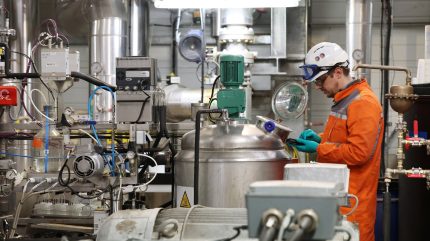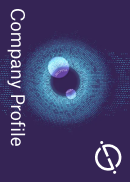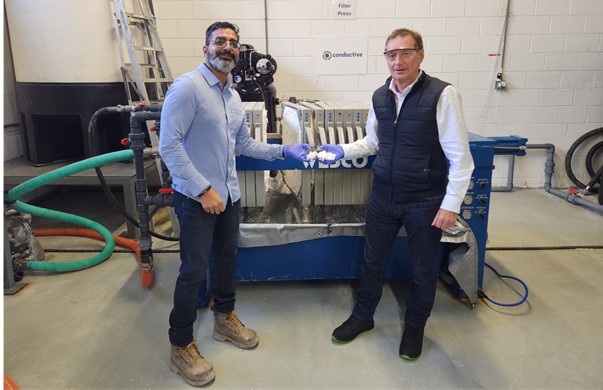
Lithium has traditionally been extracted by evaporation from brines – a process that is slow and water and land-intensive, and has tended to severely limit the sources of supply. That will not be sustainable in the future, when batteries (including those in electric vehicles) and other electrical equipment will require far greater quantities of lithium. Direct lithium extraction is a developing technology that can meet economical as well as environmental requirements in the mining of lithium.
Annual demand for lithium is already rising; it hit 165,000 tonnes (t) in 2023 and expected to reach 500,000t by 2030. However, the International Energy Agency (IEA) predicts that the market for lithium will multiply 13-fold between 2020 and 2040 under currently announced policies – and could increase 42-fold under a more aggressive ‘sustainable development’ scenario that shifts energy use from fossil to renewables and electricity.
In a blog for the World Economic Forum, Professor David Victor of the University of California, San Diego, highlighted investors’ response to that growing demand. He said: “What is interesting about lithium is how investors are responding. In 2022 alone there was a one-fifth expansion in global supplies of lithium.” He also said: “There are new technologies for producing lithium that, today, have stronger incentives for proving – such as extracting lithium from brines – which could be an important US supply.”
New lithium sources are needed that can diversify supply and reduce financial and environmental costs. Policymakers agree: the IEA called for governments to “ensure adequate investment in diversified sources of new supply”. It also called on government and industry to “promote technology innovation at all points along the value chain”, saying this “can enable more efficient use of materials, allow material substitution and unlock sizeable new supplies, thereby bringing substantial environmental and security benefits”.
The step-up in lithium supply could come from DLE, a suite of technology options that could help access more diverse supplies more quickly.
DLE technologies
Half a dozen DLE technologies are under investigation, all based on separating lithium from other minerals in brine. Adsorption, ion exchange, solvent-based and membrane options are all moving from pilot and demonstration phases to commercialisation. Two other options, electrochemical and chemical precipitation, are still at the laboratory stage.
Access the most comprehensive Company Profiles on the market, powered by GlobalData. Save hours of research. Gain competitive edge.

Your download email will arrive shortly
We are confident about the unique quality of our Company Profiles. However, we want you to make the most beneficial decision for your business, so we offer a free sample that you can download by submitting the below form
By GlobalData
In a paper published in Desalination in April this year, the authors explained that DLE technologies are not entirely new, saying: “DLE is essentially an adaptation of existing technologies… originally designed for desalination and wastewater treatment for mineral recovery […] Understanding the origin of these technologies and their pros and cons in DLE makes it possible to identify areas of potential improvement and innovation.”
They also say that: “While these DLE techniques can be effective for specific extraction sites, they cannot be interchangeable due to the varying nature and purity of brines. Therefore, the choice of each technique is tailored to the specific needs of each project.”
This could be a bar to reducing the costs of DLE quickly because it will limit the extent to which repetition can move DLE technologies along the ‘learning curve’, a process that typically allows cost to be reduced as the industry ‘learns by doing’. It is an issue the emerging DLE industry is addressing, with one technology company, Lilac Solutions (see below), saying its ion exchange technology “can handle a wide variety of brine chemistries”.
Delivering change with DLE
If DLE can deliver lithium supplies more quickly, and do it with lower energy and water use, it will become the technology of choice for lithium extraction. Lilac admits that “DLE technology has been through several hype cycles, and scepticism is understandably high”. However, the last year has seen some significant steps forward.
SQM, which operates one of the world’s biggest lithium mines, Salar de Atacama in Chile, has studied more than 70 DLE technologies and selected 12 of those for pilot testing. The company is set to make a technology selection this year, Carlos Diaz, head of SQM’s lithium division, told Reuters in June, saying the company would like to have “multiple” DLE solutions as “it is difficult to choose one that is going to fit and be suitable for all kinds of different chemicals that can be in different types of brine”.
Adsorption tech
Adsorption is the technology favoured by Standard Lithium, which describes itself as a “near-commercial lithium development company”. In April 2024, the company announced it had commissioned and validated the performance of a commercial-scale DLE column (the US’ first) at a demonstration plant near El Dorado, Arkansas. The column is a Li-ProTM Lithium Selective Sorption unit supplied by Koch Technology Solutions (KTS). It extracts lithium from brine at an input flow rate of 20.4 cubic metres (m³) per hour.
Standard Lithium has now formed a joint venture (JV) with energy company Equinor, which is developing the South West Arkansas (SWA) project. On 28 October, the JV signed a licence agreement to use Koch’s technology at the JV’s SWA phase one project. The agreement includes a guarantee of more than 95% lithium recovery from the brine, and more than 99% removal of calcium, sodium, potassium and magnesium. Andy Robinson, Standard Lithium’s director, president and COO, said: “The Li-Pro LSS technology is now sufficiently scaled-up, tested and de-risked, so not only is the JV comfortable committing to its use at commercial scale, but KTS is also able to offer performance guarantees for its commercial deployment.”
Ion exchange technology
Ion exchange technology has been used for a century and recently adapted for lithium. Lilac says extracting lithium requires a ceramic ion exchange medium, because polymer-based materials lack the necessary selectivity. However, most ceramics suitable for lithium recovery are not durable enough to withstand the acid ‘wash’ cycles that release lithium from the ceramic. Lilac claims that progress on this issue is one of its “core advancements”. On 25 June this year, the company launched a new-generation ion exchange technology that is said to improve lithium recoveries, impurity rejection, cycle life and throughput. Crucially, it claims the new product can be used in a wide range of brines with low lithium concentrations and high impurities, and says this “opens many large-scale resources in the US and Europe for development for the first time”.
Osmosis and nanofiltration membranes in DLE systems
California-based Evove uses osmosis and nanofiltration membranes in DLE systems. It says the barrier to higher membrane productivity is inherent flaws in the pore size and distribution, which means they soon reach their operational limits. It has focused on producing uniform membranes to improve performance. This year it signed a contract with the UK’s Northern Lithium to install and trial an in-field DLE demonstration plant in the UK, with successive modular expansion of the plant to reach first full-scale commercial production of battery grade lithium from 2027.
The agreement follows Evove’s earlier industrial-scale processing of saline brines extracted from Northern Lithium’s Northern Pennine Orefield and the announcement in December 2023 of a tripartite partnership between Evove, Northern Lithium and engineering company RSE. Nick Pople, Northern Lithium managing director, said: “Our goal is to achieve first commercial production from 2027 and scale up from there to 10,000-plus tonnes of battery-grade lithium delivered per year from several production areas across the Northern Pennine Orefield within the next decade.” Chris Wyres, Evove CEO, said: “The DLE plant is engineered in modules to allow scalable expansion.”
Market development
There is undoubted progress in commercialising DLE technologies, but the lithium market as a whole remains challenging.
Arcadium Lithium is a vertically integrated producer, working across hard-rock mining, conventional pond-based brine extraction, DLE and lithium chemicals manufacturing.
It was formed in January 2024 by the merger of Allchem and Livent, which had a combined total revenue in 2022 of $1.9bn. In October, Arcadium’s board recommended that shareholders accept a bid for the company by mining major Rio Tinto. Arcadium Lithium chairman Peter Coleman said the company was facing challenging market conditions as lithium prices remain depressed. He added: “Developing and expanding lithium production involves significant capital investment, construction challenges, regulatory hurdles and market risks, including unprecedented price volatility driven by changing global supply and demand dynamics. By accepting this proposed transaction from a larger, more diversified player, shareholders can avoid these risks as well as potential delays or setbacks in project execution, in exchange for immediate returns.”
While there is a shakeout of sellers in this developing industry, buyer attention is growing, particularly as a side product.
For example, extracting lithium from oil and gas wastewater has sparked interest. Lithium Harvest, a subsidiary of green technology mining company Sustainable Projects Group, has developed a proprietary adsorption technology to extract lithium from oilfield wastewater. In April, it joined with oil and gas producer Sunday Creek Horizons, planning to install several lithium operations in the Ohio River Valley in the US. Zack Space, president of Sunday Creek Horizons and a former congressman, suggested this “holds the potential to make Ohio an important player in US-produced lithium”.

Meanwhile, in the UK, on 8 November, the Cornish Lithium opened a lithium hydroxide demonstration plant at its Trelavour Hard Rock project using Lepidico processing technology. On announcing the start-up, the company also highlighted plans to extract lithium as a byproduct of geothermal energy. It said recent research “suggests that utilising new DLE technologies to extract lithium from geothermal waters, and powering extraction plants with geothermal energy, may be the most environmentally responsible way to produce this critical battery metal”.
The company said it was already in discussions with various companies that have developed DLE. The choice depends on which will work best with the local conditions, but the ultimate opportunity is to tap into “a low-impact, highly innovative opportunity that potentially extends across the whole of Cornwall”.
Later in November, CleanTech Lithium reached a “significant milestone”, producing pilot-scale lithium carbonate from Laguna Verde brine. The company shipped four tanks with a total of 88m³ of concentrated eluate from its DLE pilot plant in Copiapó, Chile, to Conductive Energy’s facility in Chicago, US, for conversion into lithium carbonate.
Commenting on the success, Haafiz Hasham, CEO of Conductive Energy, said: “This achievement highlights our commitment to developing innovative, efficient and sustainable processes that meet the growing global demand for lithium, a critical component in green energy solutions. We are excited to continue advancing direct lithium extraction, which we believe represents the future of battery-grade lithium production.”
The industry is clearly still in the painful process of commercialisation – but equally clearly, customers are ready to contemplate using DLE. The industry is preparing for lift-off.




